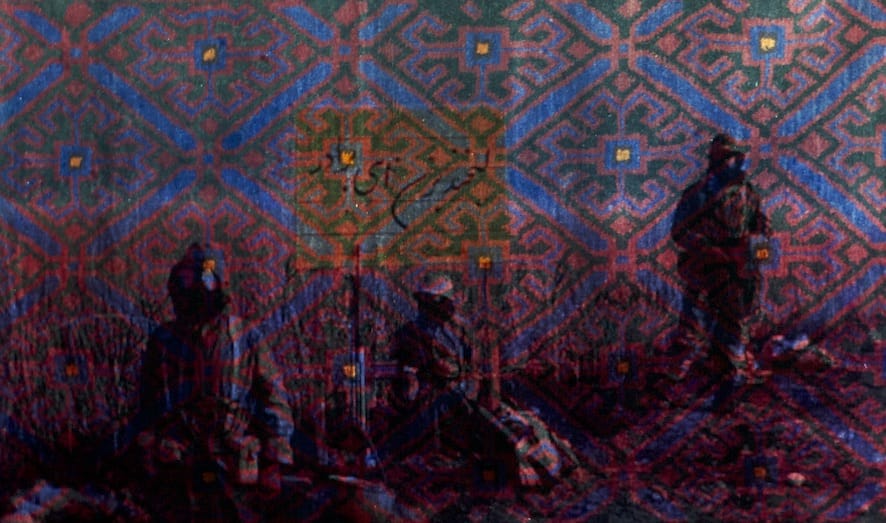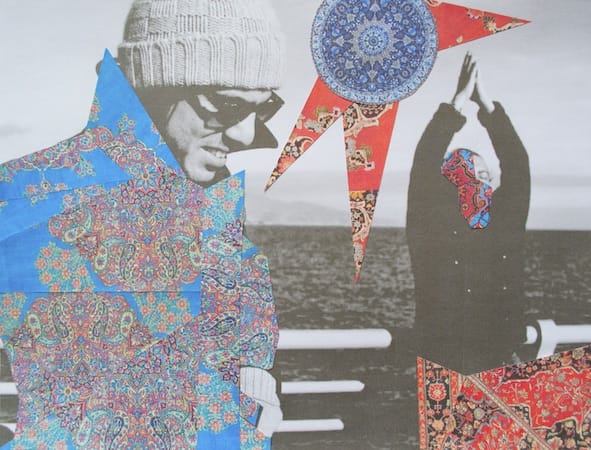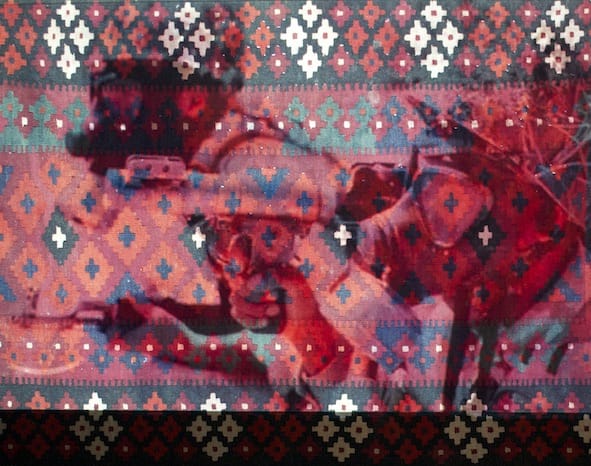I don’t know why I chose to wear snakeskin-print slippers that day, but I did. London was burning, and Nice, as the heavens would have it, wasn’t any cooler. As much as the sweat on my back was soaking through my shirt, I tried, with my dream-fazed eyes, to soak in the landscape. I hadn’t been to Nice before, and, sitting in the backseat of the taxi, fancied myself a hotshot reporter on my way to Cannes; all I needed was a tweed jacket. My eyes flickered back and forth between the idyllic scenery and the meter, which was escalating faster than we were ascending the winding mountains. I bit the back of my hot, sweaty hand, and fingered around in the pockets of my skinny blue jeans for cash. 'Would it have killed you to get a few more Euros?', I thought to myself. Step on it, mate! I hadn’t the slightest clue where we were going, and had only a vague idea of the man I was about to meet; but that’s what summers are for, aren’t they? To throw the refuge of winter to the wind, to feel, if but for a moment, like a wide-eyed child again, with the sun boring through your breast. We passed by glistening, hot bodies in faded polo shirts, while the world below dissolved into a brilliant sheet of blue. Highgate and Hampstead seemed further away than ever, then; and, after the meter hit a perfectly round fifty and I ambled out before a towering cream-coloured villa, I remembered the time I’d gotten lost in some industrial wasteland in Dubai just a few months before. 'What if this isn’t the place?', I wondered, just as I heard a voice from above and spied a tuft of dirty blonde locks. 'So you’re Sassan. Let’s see what you’ve got.' The door automatically opened, and not even the massive stone lions that greeted me were enough to wrest from me the confidence that my little snakeskin-print slippers afforded me that afternoon.
Perhaps the swanky northern suburbs of Tehran would have made for a more apt setting; but for now, Saint-Jean-Cap-Ferrat – just a stone’s throw away from Monaco – is where the man who signs with the initials B.B. calls home. Sassan Behnam Bakhtiar’s art brought us together, initially, but we soon connected on a much deeper level (French wine, of course, played no small role in this). A few months prior to our meeting, a piece of mine had appeared right before a feature on him in a well-known magazine, whose Editor had happened to conflate our names. He knew I was mad about all things Iranian, and his art – with its abundance of Iranian motifs, ancient and traditional – didn’t fail to catch my eye. He wanted to know more about the skinny kid in London banging on about Iran, and I, about the Iranophile artist I’d heard some call a ‘man on a mission’ living it up in the south of France. If it was art that first ignited a connection, a love of Iran kept the spark alight. Like my writing, Sassan’s work revolves around Iran: he writes poems about Iranian villages. He looks at Achaemenid soldiers as his brothers. He reveres the spirit of his nomadic Bakhtiari ancestors. In short, he lives and breathes Iran. But how, some may ask, did this strapping young thirty-something man born in Paris and now residing near Monaco come to devote his life and work to the culture of a country so often slighted – or, at best, ignored – in the West? And, of what stuff, exactly, is the ‘Iran’ consuming his every thought? I’ve always said that there are many ideas of Iran, each one a reality in its own right. Iran means different things to Iranians, and Sassan isn’t one to put forth his particular vision in subtle terms. He often says that he strives to show his audiences the ‘real’ Iran – that is, an ancient, glorious land, as culturally rich and influential as it was millennia ago as it is today; and you can take it or leave it. "Whoever wants to join me can join me. I’m not asking for acceptance". The foundations of the House of Sassan – to make a connection to the celebrated dynasty known, amongst other things, for having brought proud Rome to its knees on more than one occasion – were laid thirty-odd years ago in Paris. On the little metropolitan island of Ile Saint-Louis, Sassan grew up with his father, who first introduced him to painting and instilled in him a love of expression through the arts. The young artist was a Parisian, born and bred, until the age of ten, when his mother decided to take him and his brother to Tehran. The move was a life-changing one, not unlike my first visit to Iran as a teenager. "Before, I was just a typical French kid", he said, twirling around a glass of Shiraz. However, I only visited Iran as a tourist, and in the early ‘naughties’, at that. When Sassan moved to Tehran, Iran was in the throes of recovering from an eight-year-long war imposed by Saddam Hussein, and supported by the major Western powers alongside a number of Arab states. "It was a tough place to be", he remembered, "really, really hard-core". But would that it were only economic woes the young Sassan had to deal with. Being French-born and raised meant that he was looked at differently, as a ‘European kid’ and a foreigner, instead of as wholly Iranian; the situation is more or less the same today. As is the case with other Iranians who have grown up in the diaspora (yours truly included), Sassan’s detractors claim that he has little credibility to speak about things such as the ‘real’ Iran, or even express an opinion. And what does he think of them? "I don’t consider them to be educated or to know what I’m trying to do on an international level. They’re just jealous". That Sassan is an angry young man is nothing new. It was anger (positive, albeit) that fueled his desire to focus his creative energies in their entirety on Iran. ‘The difficulties, funnily enough, turned me onto Iranian culture", he recalled with a smile. Though only a teenager with no memories of pre-Revolution Iran, Sassan could feel something in his bones, and in the air. He felt a sense of nostalgia for eras he’d never experienced, perhaps much in the same way that the music of Googoosh evokes, for the many young Iranians today, the halcyon days of their parents. Bored with school, and given the cold shoulder by many of his classmates, the soon-to-be artist began wandering about the streets of Tehran, digging beneath the sullied skin of the city for its beating heart. Taxi drivers and butchers became confidantes who provided the boy with a glimpse of post-Revolution realities and put things into perspective. "My heart started bleeding for Iran", he told me, gazing glassy-eyed at the dwindling crimson elixir in his tumbler. He empathised with his new friends – most of whom belonged to social strata far removed from his – and began, in his heart and mind alike, transmuting his frustration into a constructive force. His bedroom mirror reflected not the visage of a boy whose mouth still smelled of milk, but rather, a saviour-like figure. "I could see myself leading people and inspiring them. Those experiences were the best thing that ever happened to me".
"Maria! Come and look at his shoes! And those socks!" My conversation with Sassan was pleasantly interrupted by the arrival of his wife, Maria, and their pug, Booboo. While Maria, his brother Ali, and his mother have all served as unflinching pillars of the House of Sassan, its namesake reminded me that as an artist, he has even had to prove himself amongst them. During the creation of the Real Me series, in which black-and-white photographs of the artist, as well as iconic Iranian landmarks and scenes (e.g. Persepolis and the Si-o-Seh Pol bridge in Esfahan) have been rent by vibrant, jagged streaks adorned with traditional Iranian motifs, Sassan’s ideas were questioned more than a little by those around him. It was he, however, who relished the last laugh, the series having enjoyed a number of warmly received solo exhibitions and magazine features. "Hah! Now you see", he said, grinning at Maria and tipping his glass to me with a nod. While the battle has been won at home, Sassan – as in his childhood days – still struggles to get his messages across. Some look at the angry young man as delusional and out-of-touch with reality. While Booboo clawed at my legs in desperation, Sassan stroked back his flaxen mane and recalled an incident. "Someone recently told me, 'Sassan, we love your work, but the reality you show isn’t the reality of the majority of Iranians today’". I was expecting him to flat-out disagree, and was taken aback at his answer. "Of course it isn’t – but it can be. I’m just giving you a glimpse of what Iran was and can be again". Indeed, it was his disillusionment with the present state of Iran that, in many ways, birthed his artistic career. As such, one shouldn’t be quick to deem Sassan a mere idealist, or one in denial. In listening to Sassan’s comments about post-Revolution Iran, gazing at the massive stone lions at the entrance to his villa, and being confronted at every twist and turn inside by Achaemenid soldiers, it became clear what Sassan’s ideals were as an Iranian. Though he hails from the Bakhtiar aristocracy, he doesn’t long – as many Iranians in his position are wont to do – for the ‘glory days’ of the Pahlavis. Rather, he yearns for a return to ancient and indigenous Iranian roots, which he sees as having been tainted by outside influences; in other words, a return to an Iran before the fall of the House of Sassan. That being said, though, he maintains that his fight has nothing to do with race or religion, and instead everything to do with culture, nationalism, and the elevation of the hallowed name of Iran on the global stage. "I want to show Iran to the most successful communities in the world", he said, as we later drove past a villa belonging to Prince Albert of Monaco, "because that’s what we are – if not more." It was a mellow summer’s evening in Saint-Jean-Cap-Ferrat. At the Four Seasons Hotel, a regular haunt of Sassan’s, cool glasses of rosé wine were ordered, in the spirit of the season. What I would have done, though, for a proper pint! As the soft strains of a violin came from beyond our table, draped in purest white, Sassan’s words took on grander proportions. A few paintings and collages here and there are all fine and dandy, but that isn’t going to get the neighbours to prick up their ears, and he knows it. It was then that the artist told me of his plans to establish a foundation dedicated to the promotion of contemporary Iranian art on an international level. Names of A-list individuals and venues were tossed around as if mere playthings. 'Now you’re talking', I thought, as he veered between anger and excitement, with the unbridled energy of a child. He’d show them, he said, that he was far more than just a French kid with his head in the clouds; he’d blow them out of the water, in fact, each and every one of them. It was as if he’d rehearsed every word he was telling me, so unflinching was he in his resolution, and so quick to quip at the slightest expression of doubt. He could see red carpets, towering chandeliers, the crème-de-la-crème of curators and who’s who’s of the global contemporary art scene quaffing flutes of champagne from bottles blanketed in orange, all with the same blessed name on their lips: Iran. He could envision himself doing whatever he pleased, flashing and gnashing his teeth to spite the naysayers. "I’m not doing this to make a name for myself … I’m doing this to support Iranian artists", he insisted, lest his intentions be misunderstood. 'To the Foundation’, I replied, echoing Sassan’s words and clinking my pinkish-hued glass against his. People can be so fickle; I’ll give myself credit for having learned at least one thing from the time I’ve spent in the contemporary art scene. Out of sight, out of mind, here today, gone tomorrow. When I hugged Sassan before hopping in the taxi that would take me back to dark, dank England, I didn’t think I’d ever talk to him again, let alone see him. It’s become something of an instinct, a mechanism; one learns not to expect much of people, and to regard the world with the contempt of a dervish. When Sassan calls me these days, cruising somewhere along the coast of Monaco, it’s usually to tell me of some new development concerning the Foundation: new works, bigger names, wilder parties. More often than not, he’s burnt himself out working towards some event or other, or from heading the affairs of the Bakhtiar family. Perhaps he’s more of a Bakthiar than he gives himself credit for; like those storied nomads, Sassan can never seem to sit still. He’s restless to a fault, and owes much to this unrelenting condition of his. "Sometimes I just want to turn this off", he told me that evening, tapping his head, "but I can’t".
Above me hangs, in a juicy-looking vermillion frame, a piece by Sassan entitled Once Upon a Time, there was Saddam. My thoughts are dashing between the blood-strewn sands of Khorramshahr and the city of Bowie’s heroes. I’m due to see Sassan in a few days. We won’t be seeing each other in Saint-Jean-Cap-Ferrat this time, but rather, Berlin. Neither of us has been there, and Sassan is particularly excited about the prospect of going ‘exploring’. Again, summertime; again, that season of wild abandon, sweaty palms, and wanderlust. And there we will be, a fair-haired French kid and a skinny boy from Toronto with funny socks, recalling dreams of yesteryear and lofty ambitions over blood-red wine, our hearts all the while in the land of the Lion and Sun.
Written by: Joobin Bekhrad




